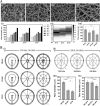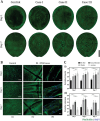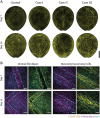Mimicking the Human Tympanic Membrane: The Significance of Scaffold Geometry
- PMID: 33945239
- PMCID: PMC11469228
- DOI: 10.1002/adhm.202002082
Mimicking the Human Tympanic Membrane: The Significance of Scaffold Geometry
Abstract
The human tympanic membrane (TM) captures sound waves from the environment and transforms them into mechanical motion. The successful transmission of these acoustic vibrations is attributed to the unique architecture of the TM. However, a limited knowledge is available on the contribution of its discrete anatomical features, which is important for fabricating functional TM replacements. This work synergizes theoretical and experimental approaches toward understanding the significance of geometry in tissue-engineered TM scaffolds. Three test designs along with a plain control are chosen to decouple some of the dominant structural elements, such as the radial and circumferential alignment of the collagen fibrils. In silico models suggest a geometrical dependency of their mechanical and acoustical responses, where the presence of radially aligned fibers is observed to have a more prominent effect compared to their circumferential counterparts. Following which, a hybrid fabrication strategy combining electrospinning and additive manufacturing has been optimized to manufacture biomimetic scaffolds within the dimensions of the native TM. The experimental characterizations conducted using macroindentation and laser Doppler vibrometry corroborate the computational findings. Finally, biological studies with human dermal fibroblasts and human mesenchymal stromal cells reveal a favorable influence of scaffold hierarchy on cellular alignment and subsequent collagen deposition.
Keywords: biofabrication; characterization tools; computational modeling; tissue engineering; tympanic membranes.
© 2021 The Authors. Advanced Healthcare Materials published by Wiley-VCH GmbH.
Conflict of interest statement
The authors declare no conflict of interest.
Figures







Similar articles
-
Multiscale fabrication of biomimetic scaffolds for tympanic membrane tissue engineering.Biofabrication. 2015 May 7;7(2):025005. doi: 10.1088/1758-5090/7/2/025005. Biofabrication. 2015. PMID: 25947357
-
Design, fabrication, and in vitro testing of novel three-dimensionally printed tympanic membrane grafts.Hear Res. 2016 Oct;340:191-203. doi: 10.1016/j.heares.2016.03.005. Epub 2016 Mar 16. Hear Res. 2016. PMID: 26994661 Free PMC article.
-
Biomimetic Tympanic Membrane Replacement Made by Melt Electrowriting.Adv Healthc Mater. 2021 May;10(10):e2002089. doi: 10.1002/adhm.202002089. Epub 2021 Jan 27. Adv Healthc Mater. 2021. PMID: 33506636 Free PMC article.
-
Can Tissue Engineering Bring Hope to the Development of Human Tympanic Membrane?Tissue Eng Part B Rev. 2021 Dec;27(6):572-589. doi: 10.1089/ten.TEB.2020.0176. Epub 2021 Feb 17. Tissue Eng Part B Rev. 2021. PMID: 33164696 Review.
-
Biofabrication of small diameter tissue-engineered vascular grafts.Acta Biomater. 2022 Jan 15;138:92-111. doi: 10.1016/j.actbio.2021.11.012. Epub 2021 Nov 13. Acta Biomater. 2022. PMID: 34781026 Review.
Cited by
-
Polyacrylamide/Gel-Based Self-Healing Artificial Tympanic Membrane for Drug Delivery of Otitis Treatment.Biomater Res. 2024 Jul 1;28:0049. doi: 10.34133/bmr.0049. eCollection 2024. Biomater Res. 2024. PMID: 38952716 Free PMC article.
-
Tunable ciprofloxacin delivery through personalized electrospun patches for tympanic membrane perforations.Bioact Mater. 2024 Apr 24;38:109-123. doi: 10.1016/j.bioactmat.2024.04.001. eCollection 2024 Aug. Bioact Mater. 2024. PMID: 38699239 Free PMC article.
-
Manufacturing Radially Aligned PCL Nanofibers Reinforced With Sulfated Levan and Evaluation of its Biological Activity for Healing Tympanic Membrane Perforations.Macromol Biosci. 2025 Jan;25(1):e2400291. doi: 10.1002/mabi.202400291. Epub 2024 Oct 26. Macromol Biosci. 2025. PMID: 39461894 Free PMC article.
-
Kidney Fibrosis In Vitro and In Vivo Models: Path Toward Physiologically Relevant Humanized Models.Adv Healthc Mater. 2025 Apr;14(9):e2403230. doi: 10.1002/adhm.202403230. Epub 2025 Feb 5. Adv Healthc Mater. 2025. PMID: 39906010 Free PMC article. Review.
-
Comparison of healing of acute total tympanic membrane perforation between rats with and without excision of the mallear handle.Laryngoscope Investig Otolaryngol. 2023 Oct 26;8(6):1648-1656. doi: 10.1002/lio2.1175. eCollection 2023 Dec. Laryngoscope Investig Otolaryngol. 2023. PMID: 38130269 Free PMC article.
References
Publication types
MeSH terms
Substances
LinkOut - more resources
Full Text Sources
Other Literature Sources

